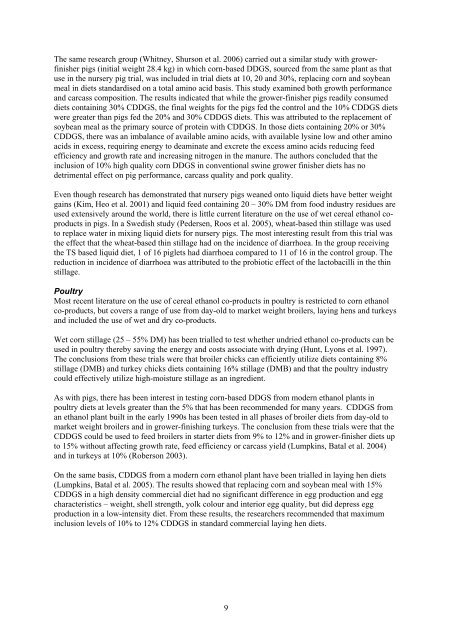Biofuel Co-Products as Livestock Feed
Biofuel Co-Products as Livestock Feed
Biofuel Co-Products as Livestock Feed
You also want an ePaper? Increase the reach of your titles
YUMPU automatically turns print PDFs into web optimized ePapers that Google loves.
The same research group (Whitney, Shurson et al. 2006) carried out a similar study with growerfinisher<br />
pigs (initial weight 28.4 kg) in which corn-b<strong>as</strong>ed DDGS, sourced from the same plant <strong>as</strong> that<br />
use in the nursery pig trial, w<strong>as</strong> included in trial diets at 10, 20 and 30%, replacing corn and soybean<br />
meal in diets standardised on a total amino acid b<strong>as</strong>is. This study examined both growth performance<br />
and carc<strong>as</strong>s composition. The results indicated that while the grower-finisher pigs readily consumed<br />
diets containing 30% CDDGS, the final weights for the pigs fed the control and the 10% CDDGS diets<br />
were greater than pigs fed the 20% and 30% CDDGS diets. This w<strong>as</strong> attributed to the replacement of<br />
soybean meal <strong>as</strong> the primary source of protein with CDDGS. In those diets containing 20% or 30%<br />
CDDGS, there w<strong>as</strong> an imbalance of available amino acids, with available lysine low and other amino<br />
acids in excess, requiring energy to deaminate and excrete the excess amino acids reducing feed<br />
efficiency and growth rate and incre<strong>as</strong>ing nitrogen in the manure. The authors concluded that the<br />
inclusion of 10% high quality corn DDGS in conventional swine grower finisher diets h<strong>as</strong> no<br />
detrimental effect on pig performance, carc<strong>as</strong>s quality and pork quality.<br />
Even though research h<strong>as</strong> demonstrated that nursery pigs weaned onto liquid diets have better weight<br />
gains (Kim, Heo et al. 2001) and liquid feed containing 20 – 30% DM from food industry residues are<br />
used extensively around the world, there is little current literature on the use of wet cereal ethanol coproducts<br />
in pigs. In a Swedish study (Pedersen, Roos et al. 2005), wheat-b<strong>as</strong>ed thin stillage w<strong>as</strong> used<br />
to replace water in mixing liquid diets for nursery pigs. The most interesting result from this trial w<strong>as</strong><br />
the effect that the wheat-b<strong>as</strong>ed thin stillage had on the incidence of diarrhoea. In the group receiving<br />
the TS b<strong>as</strong>ed liquid diet, 1 of 16 piglets had diarrhoea compared to 11 of 16 in the control group. The<br />
reduction in incidence of diarrhoea w<strong>as</strong> attributed to the probiotic effect of the lactobacilli in the thin<br />
stillage.<br />
Poultry<br />
Most recent literature on the use of cereal ethanol co-products in poultry is restricted to corn ethanol<br />
co-products, but covers a range of use from day-old to market weight broilers, laying hens and turkeys<br />
and included the use of wet and dry co-products.<br />
Wet corn stillage (25 – 55% DM) h<strong>as</strong> been trialled to test whether undried ethanol co-products can be<br />
used in poultry thereby saving the energy and costs <strong>as</strong>sociate with drying (Hunt, Lyons et al. 1997).<br />
The conclusions from these trials were that broiler chicks can efficiently utilize diets containing 8%<br />
stillage (DMB) and turkey chicks diets containing 16% stillage (DMB) and that the poultry industry<br />
could effectively utilize high-moisture stillage <strong>as</strong> an ingredient.<br />
As with pigs, there h<strong>as</strong> been interest in testing corn-b<strong>as</strong>ed DDGS from modern ethanol plants in<br />
poultry diets at levels greater than the 5% that h<strong>as</strong> been recommended for many years. CDDGS from<br />
an ethanol plant built in the early 1990s h<strong>as</strong> been tested in all ph<strong>as</strong>es of broiler diets from day-old to<br />
market weight broilers and in grower-finishing turkeys. The conclusion from these trials were that the<br />
CDDGS could be used to feed broilers in starter diets from 9% to 12% and in grower-finisher diets up<br />
to 15% without affecting growth rate, feed efficiency or carc<strong>as</strong>s yield (Lumpkins, Batal et al. 2004)<br />
and in turkeys at 10% (Roberson 2003).<br />
On the same b<strong>as</strong>is, CDDGS from a modern corn ethanol plant have been trialled in laying hen diets<br />
(Lumpkins, Batal et al. 2005). The results showed that replacing corn and soybean meal with 15%<br />
CDDGS in a high density commercial diet had no significant difference in egg production and egg<br />
characteristics – weight, shell strength, yolk colour and interior egg quality, but did depress egg<br />
production in a low-intensity diet. From these results, the researchers recommended that maximum<br />
inclusion levels of 10% to 12% CDDGS in standard commercial laying hen diets.<br />
9

















